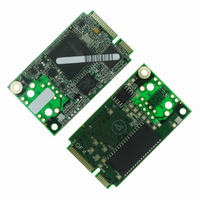20-101-1306 Rabbit Semiconductor, 20-101-1306 Datasheet - Page 34

20-101-1306
Manufacturer Part Number
20-101-1306
Description
CORE MODULE RCM5750
Manufacturer
Rabbit Semiconductor
Type
Serial to Ethernetr
Datasheet
1.20-101-1306.pdf
(119 pages)
Specifications of 20-101-1306
Module/board Type
MPU Core Module
Number Of I/os
32
Ethernet Connection Type
10/100 Base-T
Memory Type
Flash
Operating Voltage
3.3 V
Operating Current
70 mA
Operating Temperature Range
- 40 C to + 85 C
Board Size
30 mm x 51 mm x 3 mm
Product
Modules
For Use With/related Products
RCM5750
Lead Free Status / RoHS Status
Lead free / RoHS Compliant
Other names
316-1183
- Current page: 34 of 119
- Download datasheet (3Mb)
4.2 Serial Communication
The RCM5700/RCM6700 board does not have any serial level converters directly on the board.
However, an Ethernet or other serial interface may be incorporated on the board the MiniCore is
mounted on. For example, the Serial Communication accessory board in the Deluxe Development
Kit has an RS-232 transceiver, and the Interface Board has Ethernet and USB connections.
4.2.1 Serial Ports
There are six serial ports designated as Serial Ports A, B, C, D, E, and F. All six serial ports can
operate in an asynchronous mode up to the baud rate of the system clock divided by 8. An asyn-
chronous port can handle 7 or 8 data bits. A 9th bit address scheme, where an additional bit is sent
to mark the first byte of a message, is also supported.
Serial Port A is normally used as a programming port, but may be used either as an asynchronous
or as a clocked serial port once application development has been completed and the MiniCore is
operating in the Run Mode.
Serial Ports B, C, and D can also be operated in the clocked serial mode. In this mode, a clock line
synchronously clocks the data in or out. Either of the two communicating devices can supply the
clock.
Note that Alternate Serial Port B, which uses PD4 and PD5, is used together with the clock on
PB0 for the serial flash on the RCM5750/RCM5760 and RCM6700 family. If you wish to use the
regular Serial Port B I/O pins (PC4 and PC5) as serial I/O pins with the RCM5750/RCM5760 or
RCM6700 family, your application must manage its sharing of Serial Port B so as to avoid any
conflicts with using the onboard serial flash.
Serial Ports E and F can also be configured as SDLC/HDLC serial ports. The IrDA protocol is
also supported in SDLC format by these two ports. Serial Ports E and F must be configured before
they can be used. The following macros show one way to do this.
MiniCore RCM5700/RCM6700 User’s Manual
#define SERE_TXPORT PEDR
#define SERE_RXPORT PEDR
#define SERF_TXPORT PFDR
#define SERF_RXPORT PFDR
rabbit.com
34
Related parts for 20-101-1306
Image
Part Number
Description
Manufacturer
Datasheet
Request
R

Part Number:
Description:
COMPUTER SGL-BRD BL2500 29.4MHZ
Manufacturer:
Rabbit Semiconductor
Datasheet:

Part Number:
Description:
COMPUTER SGL-BRD BL2500 29.4MHZ
Manufacturer:
Rabbit Semiconductor
Datasheet:

Part Number:
Description:
DISPLAY GRAPHIC 12KEY PROG OP670
Manufacturer:
Rabbit Semiconductor
Datasheet:

Part Number:
Description:
DISPLAY GRAPHIC 12KEY ETH OP6700
Manufacturer:
Rabbit Semiconductor
Datasheet:

Part Number:
Description:
COMPUTER SINGLE-BOARD BL2030
Manufacturer:
Rabbit Semiconductor

Part Number:
Description:
COMPUTER SGL-BOARD ETH BL2010
Manufacturer:
Rabbit Semiconductor

Part Number:
Description:
MODULE OP6810 W/O ETH/MEM EXPANS
Manufacturer:
Rabbit Semiconductor
Datasheet:

Part Number:
Description:
COMPUTER SINGLE-BOARD BL2020
Manufacturer:
Rabbit Semiconductor

Part Number:
Description:
COMPUTER BL2010 W/FRICTION LOCK
Manufacturer:
Rabbit Semiconductor

Part Number:
Description:
COMPUTER BL2020 W/FRICTION LOCK
Manufacturer:
Rabbit Semiconductor

Part Number:
Description:
COMPUTER SGL-BRD BL2500 44.2MHZ
Manufacturer:
Rabbit Semiconductor
Datasheet:

Part Number:
Description:
COMPUTER SGL-BOARD FULL BL2000
Manufacturer:
Rabbit Semiconductor

Part Number:
Description:
COMPUTER SINGLE-BOARD BL2110
Manufacturer:
Rabbit Semiconductor

Part Number:
Description:
COMPUTER SGL-BRD 29.4MHZ BL2610
Manufacturer:
Rabbit Semiconductor
Datasheet:

Part Number:
Description:
INTERFACE OP6800 512K FLASH&SRAM
Manufacturer:
Rabbit Semiconductor
Datasheet:










